ANDERSON TODD, 1921-2018 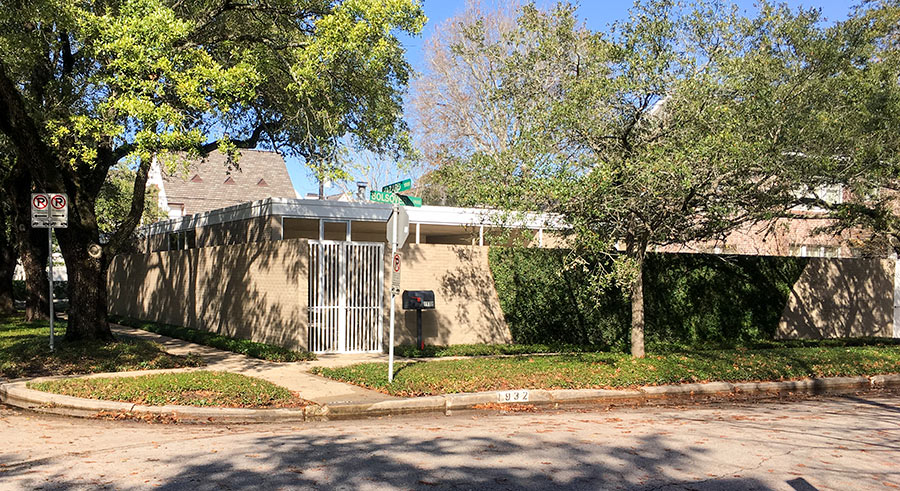 Tucked back on a corner lot a block north of Rice is one of the courtyard houses Anderson Todd designed and lived in during his nearly 70 years in Houston. It’s shown above in all its flat-roofed glory. Like many of the buildings Todd dreamed up around town, the house rests on principles he took from German architect Ludwig Mies van der Rohe, his teacher at Princeton and mentor thereafter. Upon joining Rice’s then-not-so-modern architecture department in 1949, Todd set about implanting Miesian concepts in his students’ brains for the next 4 decades. He also found time to convince Mies himself to design 2 successive additions to the MFAH: Cullinan Hall and the Brown Pavilion, notes the Chronicle‘s Jasper Scherer. Todd retired from his professorial duties in 1992, and, last Friday, passed away at the age of 97. [Houston Chronicle] Photo: Swamplox inbox
Tucked back on a corner lot a block north of Rice is one of the courtyard houses Anderson Todd designed and lived in during his nearly 70 years in Houston. It’s shown above in all its flat-roofed glory. Like many of the buildings Todd dreamed up around town, the house rests on principles he took from German architect Ludwig Mies van der Rohe, his teacher at Princeton and mentor thereafter. Upon joining Rice’s then-not-so-modern architecture department in 1949, Todd set about implanting Miesian concepts in his students’ brains for the next 4 decades. He also found time to convince Mies himself to design 2 successive additions to the MFAH: Cullinan Hall and the Brown Pavilion, notes the Chronicle‘s Jasper Scherer. Todd retired from his professorial duties in 1992, and, last Friday, passed away at the age of 97. [Houston Chronicle] Photo: Swamplox inbox
Tag: Obituaries
PETER H. BROWN, 1936–2017 Peter Brown, who passed away yesterday, wore many hats — he was an urban planner, architect, neighborhood activist, city council member, and occasional rapper — as well several distinctive long scarves. Amidst other civic legacies, he leaves behind a substantial back catalog of YouTube videos — in which an unseen cameraperson chronicles Brown’s peripatetic musings on various aspects of Houston’s occasionally urban landscape. As “Pedestrian Pete” on both a Facebook page and YouTube channel of the same name, Brown explored “the good, the bad, and the ugly pedestrian conditions of Houston”: He scoured neighborhoods in search of traversable sidewalks, railed against car-centric attributes of the Heights Walmart, and strolled along Lower Westheimer in conversation with Annise Parker, who had defeated him in his 2009 run for mayor. Brown was 81. [Houston Chronicle; previously on Swamplot] Video: Pedestrian Pete
GUNNAR BIRKERTS, 1925-2017 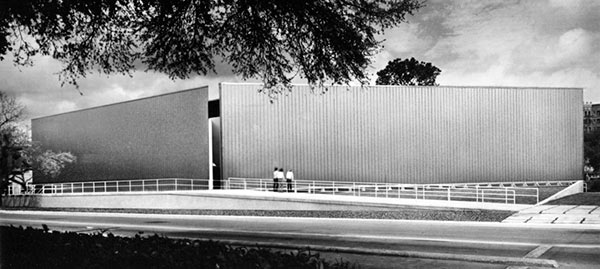 Latvian-born architect Gunnar Birkerts, designer of the stainless-steel-clad Contemporary Arts Museum that’s stood at the northwest corner of Montrose Blvd. and Bissonnet St. since 1972, passed away yesterday at the age of 92. Birkerts moved to Michigan in 1949 after graduating from architecture school in Germany; he later worked in the office of Eero Saarinen and set up his own architectural practice in Birmingham, a Detroit suburb. The exterior of the CAMH was altered to its current appearance in 1997 after a design by Houston architect Bill Stern. [Chicago Tribune; more here] Photo: CAMH
Latvian-born architect Gunnar Birkerts, designer of the stainless-steel-clad Contemporary Arts Museum that’s stood at the northwest corner of Montrose Blvd. and Bissonnet St. since 1972, passed away yesterday at the age of 92. Birkerts moved to Michigan in 1949 after graduating from architecture school in Germany; he later worked in the office of Eero Saarinen and set up his own architectural practice in Birmingham, a Detroit suburb. The exterior of the CAMH was altered to its current appearance in 1997 after a design by Houston architect Bill Stern. [Chicago Tribune; more here] Photo: CAMH
BART TRUXILLO, 1942-2017 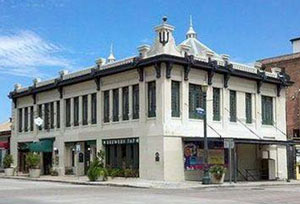 In 2006, the former brewery structure now hosting the Magnolia Ballroom was the first building in Houston to get protected landmark status — and was not the last, probably thanks in part to the life work of its restorer. Bart Truxillo bought the then-vacant building on the edge of Market Square in the late sixties, not too long before buying and restoring the crumbling Queen Anne Mansfield house in the Heights; both structures are now on the National Register of Historic Places. Truxillo later helped found what’s today known as Preservation Houston, and start the organization’s Good Brick Awards during the demolition-rich years of Houston’s first oil boom, as Lisa Gray notes today in the Chronicle; after years of work restoring historic buildings around town and serving a bunch of other history-minded groups, he died yesterday at age 74. [Houston Chronicle; previously on Swamplot] Photo of Magnolia Ballroom building on Franklin St.: Brewery Tap HTX
In 2006, the former brewery structure now hosting the Magnolia Ballroom was the first building in Houston to get protected landmark status — and was not the last, probably thanks in part to the life work of its restorer. Bart Truxillo bought the then-vacant building on the edge of Market Square in the late sixties, not too long before buying and restoring the crumbling Queen Anne Mansfield house in the Heights; both structures are now on the National Register of Historic Places. Truxillo later helped found what’s today known as Preservation Houston, and start the organization’s Good Brick Awards during the demolition-rich years of Houston’s first oil boom, as Lisa Gray notes today in the Chronicle; after years of work restoring historic buildings around town and serving a bunch of other history-minded groups, he died yesterday at age 74. [Houston Chronicle; previously on Swamplot] Photo of Magnolia Ballroom building on Franklin St.: Brewery Tap HTX
TERRY HERSHEY, 1922-2017  The stretch of Buffalo Bayou running between the Addicks and Barker reservoirs and Shepherd Dr. looks the way it does today in large part because Terry Hershey and some friends spotted the unannounced work to pave and reroute the bayou — and raised some hell about it with the county, the Corps of Engineers, and others. The early actions of Hershey and her associates stopped the pave-over, led to the founding of what became the Bayou Preservation Association, aided the passage of the National Environmental Policy Act (which requires public involvement in projects that could impact the environment), and helped to catalyze Houston’s environmental movement. Hershey’s legacy includes founding, laying groundwork for, and participating in many other organizations to protect green space and environmental quality in Houston and throughout the state, many of which are still active today; the 6-mile park along Buffalo Bayou between Hwy. 6 and Beltway 8 is named for her. Hershey passed away today at age 94. [Houston History, Houston Chronicle] Photo of Terry Hershey Park: Save Buffalo Bayou
The stretch of Buffalo Bayou running between the Addicks and Barker reservoirs and Shepherd Dr. looks the way it does today in large part because Terry Hershey and some friends spotted the unannounced work to pave and reroute the bayou — and raised some hell about it with the county, the Corps of Engineers, and others. The early actions of Hershey and her associates stopped the pave-over, led to the founding of what became the Bayou Preservation Association, aided the passage of the National Environmental Policy Act (which requires public involvement in projects that could impact the environment), and helped to catalyze Houston’s environmental movement. Hershey’s legacy includes founding, laying groundwork for, and participating in many other organizations to protect green space and environmental quality in Houston and throughout the state, many of which are still active today; the 6-mile park along Buffalo Bayou between Hwy. 6 and Beltway 8 is named for her. Hershey passed away today at age 94. [Houston History, Houston Chronicle] Photo of Terry Hershey Park: Save Buffalo Bayou
WHAT MICHAEL GRAVES BROUGHT TO HOUSTON 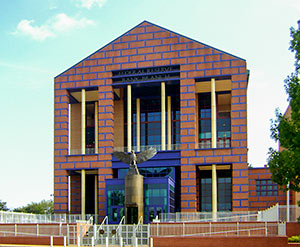 Is Michael Graves personally to blame for the infestations of flattened pediments that began appearing on commercial building façades in the early nineties, and later morphed into the default “look” for the standard midsprawl shopping center?
Not really. But the early acclaim his variety of postmodern design received did play some role in the license now apparently felt by thousands of lesser architects (and developers) to festoon dull commercial designs with all sorts of cartooned classical elements — and declare the result to be “traditional.” By the time the New Jersey-based architect designed his 2 Houston building projects in the early naughts, he had moved on to super-scaling other building elements: His Martel College and Master’s house at Rice and the Federal Reserve Bank (of Dallas!) on Allen Pkwy. (pictured above) are both dressed in a sort of Lego-like big-brick wallpaper, but one “drawn” using actual-size bricks. After an infection he contracted in 2003 left him paralyzed from the waist down, Graves became an outspoken champion of universal design. Graves passed away last week at the age of 80; Writer Michael Hardy has a remembrance of the man he calls “the architect Houston loved to hate.” [Houstonia] Photo: John D. Cramer
Is Michael Graves personally to blame for the infestations of flattened pediments that began appearing on commercial building façades in the early nineties, and later morphed into the default “look” for the standard midsprawl shopping center?
Not really. But the early acclaim his variety of postmodern design received did play some role in the license now apparently felt by thousands of lesser architects (and developers) to festoon dull commercial designs with all sorts of cartooned classical elements — and declare the result to be “traditional.” By the time the New Jersey-based architect designed his 2 Houston building projects in the early naughts, he had moved on to super-scaling other building elements: His Martel College and Master’s house at Rice and the Federal Reserve Bank (of Dallas!) on Allen Pkwy. (pictured above) are both dressed in a sort of Lego-like big-brick wallpaper, but one “drawn” using actual-size bricks. After an infection he contracted in 2003 left him paralyzed from the waist down, Graves became an outspoken champion of universal design. Graves passed away last week at the age of 80; Writer Michael Hardy has a remembrance of the man he calls “the architect Houston loved to hate.” [Houstonia] Photo: John D. Cramer
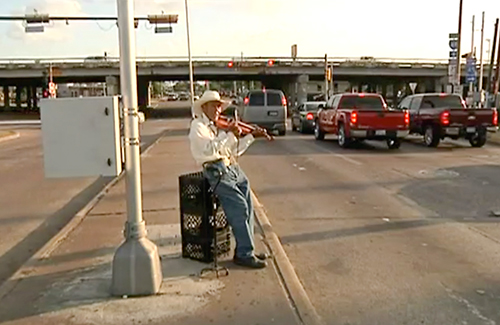
Don Luis Cruz, also known as the octogenarian violinist often found trilling and harmonizing with Gulfgate traffic, passed away yesterday at Pasadena’s Bayshore Medical Center, having reached the age of 90. He was a daily fixture at the intersection of Woodridge Dr. and the Gulf Fwy. feeder road until the summer of 2012, when he was beaten by a man in a wheelchair over the money in Cruz’s violin case. “Over the years,” writes the Chronicle‘s Craig Hlavaty, “crooks targeted The Violin Man for his tip money, bike, moped and even his amp. After each incident, however, Cruz would ignore his family’s pleas and head back out to his corner.” This video feature on Cruz’s string habit aired on Telemundo in 2011:
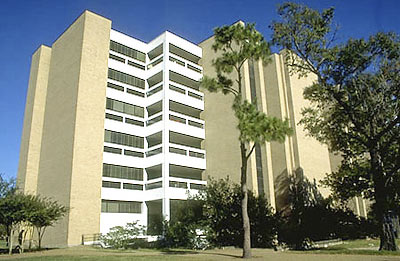
Architect Kenneth Bentsen designed quite a few institutional buildings in Houston, including Phillip Guthrie Hoffman Hall and Agnes Arnold Hall, shown here, at the University of Houston campus. Other buildings to Bentsen’s name include the Texas Children’s Hospital Complex and the Houston Summit (which is now, of course, Lakewood Church). As an architecture student at UH, Bentsen worked with Donald Barthelme and Howard Barnstone and began his career in the ’50s at MacKie and Kamrath. He ran his own practice here from 1958 until 1991. Bentsen passed away this week on Tuesday, September 24.
- Lloyd M. Bentsen, Jr., House [Houston Mod]
Photo: University of Houston
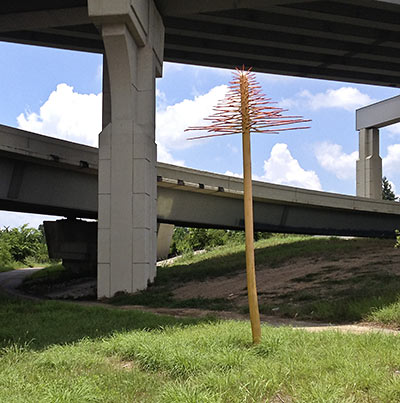
You’ve probably seen one of these Salvador Dali-meets-Dr. Seuss installations poking out somewhere around town: Most made out of sticks, tree trunks, bamboo shoots, and gobs of paint, they’re the work of Lee Littlefield, who died of complications from lung cancer at his Houston home yesterday. This “pop-up,” as the sculptures came to be known, can be seen on the north side of westbound I-10. It’s just across all those lanes from a periscope-like pink one that seems to be straining to get a peak of the polo grounds at Memorial Park:
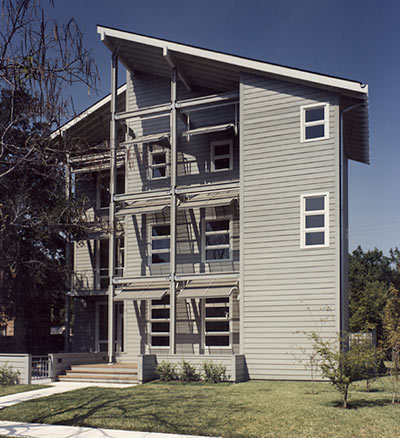
Houston’s growing reputation as an architectural hotspot attracted Bill Stern to the city in 1976. He began by working for the grandaddy of the city’s Tin Houses, Eugene Aubry; later he helped popularize the very “Houston” look favored by many other architects who had gathered around the Menils — beginning in 1992 with his own 3-story louvered home at the corner of Milford and Mt. Vernon in the Museum District (above) and continuing with many subsequent buildings designed by his firm, renamed Stern and Bucek Architects in 1999. In addition to their own designs, Stern and Bucek helped preserve, renovate, and reuse Modern structures, including the Menils’ own 1950 home on San Felipe by Philip Johnson, the Frame-Harper House, the CAMH, and the Miller Outdoor Theater. Stern was an art collector and a founding editor of the Rice Design Alliance’s Cite magazine; he taught at UH for almost 30 years. Pancreatic cancer cut his life short; Stern died Friday in his Milford St. home.
- Houston architect Stern dies a day after receiving top award [Houston Chronicle]
- William Stern, FAIA, LEED AP [Stern and Bucek Architects]
Photo of 1202 Milford St.: Stern and Bucek Architects
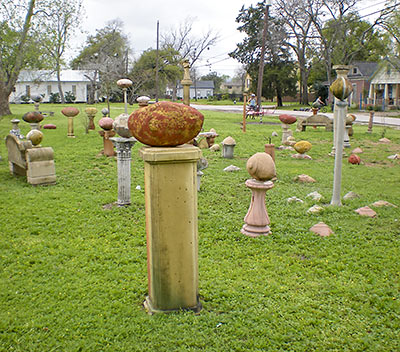
Houston artist Bert Long passed away of pancreatic cancer earlier today. He was 72. This photo shows one of Long’s most recognizable pieces: “Field of Vision” is located across the street from Emancipation Park on the corner of Elgin and Bastrop, next door to the Eldorado Ballroom. Born in the Fifth Ward, Long worked as a Hyatt Regency executive chef before pursuing an arts career. “Bert would walk in anywhere. He’d do anything,” Long’s friend James Surls tells the Houston Chronicle. “He was unabashed and unafraid.”
- Biography [Bert Long]
- Houston artist Bert Long Jr. dies [Houston Chronicle]
Photo: Allyn West
KICK A BUILDING IN MEMORIAM Former New York Times architecture critic Ada Louise Huxtable liked Houston. In 1976, she called it “the city of the second half of the twentieth century.†It’s the first half of the twenty-first century now. Houston’s status is no more cemented than it was then, but Huxtable’s is. She passed away yesterday at her home in Manhattan, at the age of 91. [New York Times]

